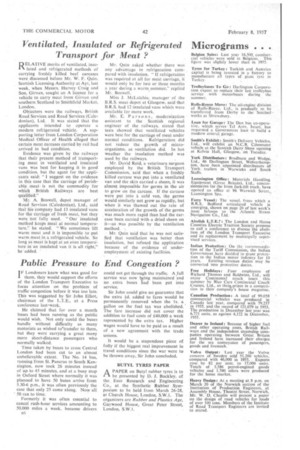Ventilated, Insulated or Refrigerated Transport for Meat ?
Page 40

If you've noticed an error in this article please click here to report it so we can fix it.
ELATIVE merits of ventilated, insulated and refrigerated methods of carrying freshly killed beef carcases were discussed before Mr. W. F. Quin, Scottish Licensing Authority at Ayr, last week, when Messrs. Harvey Craig and Son, Girvan, sought an A licence for a vehicle to carry meat from Girvan and southern Scotland to Smithfield Market, London.
Objectors were the railways, British Road Services and Road Services (Caledonian), Ltd. It was stated that the applicants intended to operate a modern refrigerated vehicle. A supporting letter from London Corporation Medical Officer of Health alleged that certain meat carcases carried by rail had arrived in bad condition.
Evidence was given by the railwaya that their present method of transporting meat in ventilated and insulated vans was best for keeping it in good condition, but the agent for the applicants said: " I suggest on the evidence in this case that the carriage of perishable meat. is not the commodity for which British Railways are best qualified."
Mr. A. Boswell, depot manager of Road Services (Caledonian), Ltd., said that his company had 13 insulated vans for the carriage of fresh meat, but they were not fully used. "Our insulated method keeps meat at normal temperature," he stated: " We sometimes lift warm meat and it is impossible to put warm meat M a refrigerated vehicle. So long as meat is kept at an even tempera-tore in an insulated van it is all right," he added.
Mr. Quin asked whether there was any advantage in refrigeration compared with insulation. " If refrigeration was required at all for meat carriage, it would only be for two or three months a year during a warm summer," replied Mr. Boswell.
Miss J. IvIcLatchie, manager of the B.R.S. meat depot at Glasgow, said that B.R.S. had 12 insulated vans which were available for more work.
Mr. E. Parsons, modernization assistant to the Scottish regional engineer of the railways, stated that tests showed that ventilated vehicles were best for the carriage of meat under normal conditions. Refrigeration did not reduce the growth of microorganisms, as ventilation did. In hot weather the insulation method was used by the railways.
Mr. David Reid, a veterinary surgeon employed by the British Transport Commission, said that when a freshly killed carcase was put into a ventilated van and the skin carried a sheen, it was almost impossible for germs in the air to grow on the carcase. If the carcase were put into i cold van, the germs would similarly not grow as rapidly, but when it was thawed out the rate of acceleration of the growth of the germs was much more rapid than had the carcase been carried with a dried sheen on itas was possible by the ventilation method. , Mr. Quin said that he was not satisfied that ventilation was better than insulation, but refused the application because of the evidence of underemployment of existing facilities.




































































































